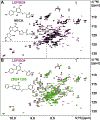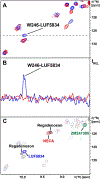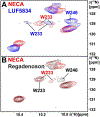A2A Adenosine Receptor Partial Agonism Related to Structural Rearrangements in an Activation Microswitch
- PMID: 33238145
- PMCID: PMC7867584
- DOI: 10.1016/j.str.2020.11.005
A2A Adenosine Receptor Partial Agonism Related to Structural Rearrangements in an Activation Microswitch
Abstract
In drug design, G protein-coupled receptor (GPCR) partial agonists enable one to fine-tune receptor output between basal and maximal signaling levels. Here, we add to the structural basis for rationalizing and monitoring partial agonism. NMR spectroscopy of partial agonist complexes of the A2A adenosine receptor (A2AAR) revealed conformations of the P-I-F activation motif that are distinctly different from full agonist complexes. At the intracellular surface, different conformations of helix VI observed for partial and full agonist complexes manifest a correlation between the efficacy-related structural rearrangement of this activation motif and intracellular signaling to partner proteins. While comparisons of A2AAR in complexes with partial and full agonists with different methods showed close similarity of the global folds, this NMR study now reveals subtle but distinct local structural differences related to partial agonism.
Keywords: G protein-coupled receptors; NMR spectroscopy; drug efficacy; partial agonists.
Copyright © 2020 Elsevier Ltd. All rights reserved.
Conflict of interest statement
Declaration of Interests The authors declare no competing interests.
Figures




Similar articles
-
Activation of adenosine A2A receptor by lipids from docosahexaenoic acid revealed by NMR.Sci Adv. 2020 Mar 18;6(12):eaay8544. doi: 10.1126/sciadv.aay8544. eCollection 2020 Mar. Sci Adv. 2020. PMID: 32206717 Free PMC article.
-
Activation of the A2A adenosine G-protein-coupled receptor by conformational selection.Nature. 2016 May 12;533(7602):265-8. doi: 10.1038/nature17668. Epub 2016 May 4. Nature. 2016. PMID: 27144352
-
Allosteric Coupling of Drug Binding and Intracellular Signaling in the A2A Adenosine Receptor.Cell. 2018 Jan 11;172(1-2):68-80.e12. doi: 10.1016/j.cell.2017.12.004. Epub 2017 Dec 28. Cell. 2018. PMID: 29290469 Free PMC article.
-
Agonist-bound structures of G protein-coupled receptors.Curr Opin Struct Biol. 2012 Aug;22(4):482-90. doi: 10.1016/j.sbi.2012.03.007. Epub 2012 Apr 3. Curr Opin Struct Biol. 2012. PMID: 22480933 Review.
-
Adenosine A2A receptor as a drug discovery target.J Med Chem. 2014 May 8;57(9):3623-50. doi: 10.1021/jm4011669. Epub 2013 Nov 15. J Med Chem. 2014. PMID: 24164628 Review.
Cited by
-
G Protein-coupled Receptor (GPCR) Reconstitution and Labeling for Solution Nuclear Magnetic Resonance (NMR) Studies of the Structural Basis of Transmembrane Signaling.Molecules. 2022 Apr 20;27(9):2658. doi: 10.3390/molecules27092658. Molecules. 2022. PMID: 35566006 Free PMC article. Review.
-
Sub-millisecond conformational dynamics of the A2A adenosine receptor revealed by single-molecule FRET.Commun Biol. 2023 Apr 3;6(1):362. doi: 10.1038/s42003-023-04727-z. Commun Biol. 2023. PMID: 37012383 Free PMC article.
-
Global insights into the fine tuning of human A2AAR conformational dynamics in a ternary complex with an engineered G protein viewed by NMR.Cell Rep. 2022 Dec 20;41(12):111844. doi: 10.1016/j.celrep.2022.111844. Cell Rep. 2022. PMID: 36543140 Free PMC article.
-
Structural Insights into Partial Activation of the Prototypic G Protein-Coupled Adenosine A2A Receptor.ACS Pharmacol Transl Sci. 2024 Apr 29;7(5):1415-1425. doi: 10.1021/acsptsci.4c00051. eCollection 2024 May 10. ACS Pharmacol Transl Sci. 2024. PMID: 38751633 Free PMC article.
-
Membrane Mimetic-Dependence of GPCR Energy Landscapes.bioRxiv [Preprint]. 2023 Oct 19:2023.10.16.562552. doi: 10.1101/2023.10.16.562552. bioRxiv. 2023. Update in: Structure. 2024 May 2;32(5):523-535.e5. doi: 10.1016/j.str.2024.01.013. PMID: 37905159 Free PMC article. Updated. Preprint.
References
-
- Al Jaroudi W, and Iskandrian AE (2009). Regadenoson: A new myocardial stress agent. Journal of the American College of Cardiology 54, 1123–1130. - PubMed
-
- Ballesteros J, and Weinstein H (1995). Integrated methods for modeling G-protein coupled receptors. Methods Neurosci 25, 366–428.
-
- Beukers MW, Chang LCW, von Frijtag Drabbe Künzel JK, Mulder-Krieger T, Spanjersberg RF, Brussee J, and IJzerman AP (2004). New, non-adenosine, high-potency agonists for the human adenosine A2B receptor with an improved selectivity profile compared to the reference agonist n-ethylcarboxamidoadenosine. Journal of Medicinal Chemistry 47, 3707–3709. - PubMed
-
- Browne CA, Smith T, and Lucki I (2020). Behavioral effects of the kappa opioid receptor partial agonist nalmefene in tests relevant to depression. European Journal of Pharmacology 872, 1–7. - PubMed
-
- Calverley PMA, Anderson JA, Celli B, Ferguson GT, Jenkins C, Jones PW, Yates JC, and Vestbo J (2007). Salmeterol and fluticasone propionate and survival in chronic obstructive pulmonary disease. New England Journal of Medicine 356, 775–789. - PubMed
Publication types
MeSH terms
Substances
Grants and funding
LinkOut - more resources
Full Text Sources
Other Literature Sources
Research Materials

